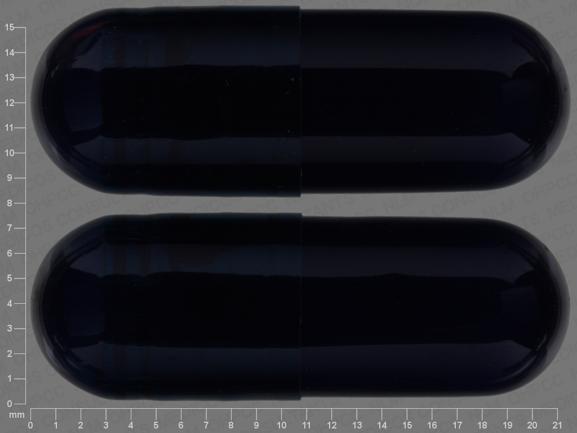Prussian Blue Dosage
Medically reviewed by Drugs.com. Last updated on Aug 18, 2025.
Applies to the following strengths: 500 mg
Usual Adult Dose for:
Usual Pediatric Dose for:
Additional dosage information:
Usual Adult Dose for Radiation Emergency
3 grams (6 capsules) orally 3 times a day; total daily dose of 9 grams
Comments:
- Take with food to stimulate excretion of cesium or thallium.
- When possible, obtain quantitative baseline of the internalized contamination by radioactive cesium (137Cs) and/or thallium by appropriate whole-body counting and/or by bioassay (e.g., biodosimetry), or feces/urine samples prior to treatment.
- Initiate treatment as soon as possible after contamination is suspected. Even when delayed, treatment is effective and should not be withheld.
- Treatment may last 30 days or longer.
- Base treatment duration on weekly measurements of radioactivity in urine and feces to monitor cesium/thallium elimination rate.
- Continue treatment for thallium contamination until a 24 hour urine thallium test is normal (less than 5 mcg/L) and radiation level (if applicable) is acceptable.
Use: Treatment of patients with known or suspected internal contamination with radioactive cesium and/or radioactive or non-radioactive thallium to increase their rates of elimination.
Usual Pediatric Dose for Radiation Emergency
2 to 12 years: 1 gram (2 capsules) orally 3 times a day; total daily dose of 3 grams
13 to 18 years: 3 grams (6 capsules) orally 3 times a day; total daily dose of 9 grams
Comments:
- Take with food to stimulate excretion of cesium or thallium.
- When possible, obtain quantitative baseline of the internalized contamination by radioactive cesium (137Cs) and/or thallium by appropriate whole-body counting and/or by bioassay (e.g., biodosimetry), or feces/urine samples prior to treatment.
- Initiate treatment as soon as possible after contamination is suspected. Even when delayed, treatment is effective and should not be withheld.
- Treatment may last 30 days or longer.
- Base treatment duration on weekly measurements of radioactivity in urine and feces to monitor cesium/thallium elimination rate.
- Continue treatment for thallium contamination until a 24 hour urine thallium test is normal (less than 5 mcg/L) and radiation level (if applicable) is acceptable.
Use: Treatment of patients with known or suspected internal contamination with radioactive cesium and/or radioactive or non-radioactive thallium to increase their rates of elimination.
Renal Dose Adjustments
Data not available
Liver Dose Adjustments
Data not available.
This drug may be less effective in patients with hepatic impairment due to decreased excretion of cesium and thallium in the bile.
Precautions
Safety and efficacy have not been established in patients younger than 2 years.
Consult WARNINGS section for additional precautions.
Dialysis
Data not available
Other Comments
Administration advice:
- In patients who cannot tolerate swallowing large numbers of capsules, open the capsules and mix with bland food or liquids.
Storage requirements:
- Store at 68 to 77F (20 to 25C)
General:
In cases of severe thallium intoxication, additional types of treatment may be necessary, such as:
- Induced emesis, followed by gastric intubation and lavage
- Forced diuresis until urinary thallium excretion is less than 1 mg/24 hours
- Charcoal hemoperfusion may be useful during the first 48 hours after thallium ingestion (biodistribution phase)
- Hemodialysis has also been reported to be effective in thallium intoxication
- Prior to initiating treatment, follow radioactive decontamination procedures including use of appropriate radiation protective attire, monitoring personnel and treatment areas using radiation detection, indication, and computation devices (RADIAC) or thermal luminescent devices (LTD), and control spread of radiation contamination by establishing a patient decontamination area and a contaminated material disposal site (with proper labeling, handling, and disposal of contaminated materials).
Monitoring:
- Obtain weekly laboratory evaluations (complete blood count, serum chemistry, and electrolytes).
- Monitor elderly patients closely as they are more likely to have decreased cardiac function, concomitant disease, or other drug therapy.
Patient advice:
- Inform patients that this drug can decrease gastrointestinal motility, increasing the radiation absorbed.
- Patients should watch for constipation and seek medical management if symptoms develop.
- Inform patients of safety measures to minimize radiation exposure to themselves and others, including appropriate use of the toilet, hand washing, and handling items that might get contaminated with body fluids.
- Inform patients that their stools may be blue colored, and if the capsules are opened and mixed with food, their mouths and teeth may be blue colored.
Frequently asked questions
More about prussian blue
Patient resources
Other brands
Professional resources
Other brands
Related treatment guides
See also:
Further information
Always consult your healthcare provider to ensure the information displayed on this page applies to your personal circumstances.


